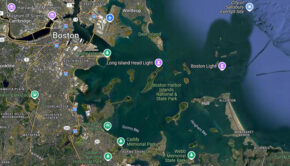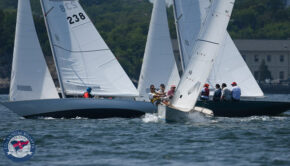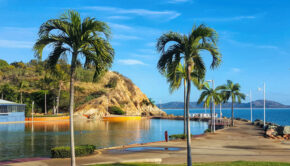Years ahead of its time
Published on January 10th, 2022
In his January column for Seahorse magazine, Paul Cayard reflects on how his introduction to sailing was so random and so right. Scuttlebutt thanks Seahorse editor Andrew Hurst for allowing us to share this story:
Every period of our lives has a special significance. It seems that the ones in our youth leave the strongest impressions. Such is the case for me and my junior sailing.
I started sailing at the age of eight, completely by accident. A classmate of mine in second grade invited me to go sailing, on a borrowed boat, from the Rec department on Lake Merritt in downtown Oakland, California. My classmate’s family weren’t big sailors and no one in my family sailed. From there I had a 35-year professional sailing career and am now leading the US Olympic Sailing Team. How random is that?
When I was eight, my father built me a boat in our garage in San Francisco which I raced on lakes around the Bay Area. At 13, while sailing in the Sears Cup, I met some slightly older kids… 16 years old, who were members of St. Francis Yacht Club and in the junior program there. They had six 420s at the time and invited me to go for a sail one day.
I got my 1971-era wetsuit on and went out with Zan Dredjes, a hippy kid from Marin, for a burn. A 420 with trapeze and spinnaker seemed so big at 13. Shortly thereafter I began crewing on Fireballs while still racing my El Toro and won the North American Championship in both classes in 1975. It was then that the powers at St Francis Yacht Club asked me to join.
The junior program at St Francis was led by Paxton (Packy) Davis and Don Trask. Both are still with us at the age of 90 today. These two outstanding humans gave enormously of themselves to cultivate a squad that included John Bertrand, John Kostecki, Craig Healy, Paul Cayard, Ken Keefe, Steve Jeppesen, Zan Dredjes, and Russ Silvestri. We invited Jeff Madrigali to hang with us even though he was from another club.
The Laser class had just started, and the club bought 10 and doled them out. Don was building the Lasers at Performance Sailcraft in San Rafael. The club bought a van and Don and Packy built a custom trailer that would hold all 10 Lasers. They gave us a gas card. Amazing how much stuff you could buy on a Chevron gas card!
We traveled together constantly, up and down the California coast from Newport Beach to Clear Lake to Tinsley Island. We had big rivalries with Jimmy Buckingham, Scott Mason, Tony Watson, and Phil Ramming of Newport Harbor Yacht Club.
Every weekend was a new adventure. While we were having fun, unbeknown to us, we were building a powerful squad. A pocket of talent that would go on to win the America’s Cup, round-the-world races, and Olympic medals.
We were always together… a gang, a squad, a band. We learned to drive together, we learned to drink together, we played basketball together, we dated girls together, we land-surfed on skateboards with maxi bags as sails.
But mostly, we sailed together… even weekday afternoons, after school. Sometimes, Don and Packy would join us in a whaler (no RIBS back then). We would race around fixed marks on a short track. Laps, Reps. Inflatable marks weren’t invented yet. If you hit steel, it hurt.
Our field was San Francisco Bay, a treacherous piece of water off the otherwise peaceful Pacific Ocean. On a summer afternoon, with the current going at 2kt out the gate and the 59° wind pushing in at 25kt+, what you have is the Octagon of Sailing.
And that’s when we would rig up. We never sailed in 10kt of wind. I can’t remember ever going out in 10kt of wind. And when we went down to So Cal we would get our asses kicked by Buck & Co. But when they came to SF, we couldn’t see them.
We owned heavy-air sailing. Remember the Laser Heavy Weather Slalom? Dave Perry does. Carl Buchan does. Fourth of July weekend. Two courses, side by side; four buoys over 100m, top to bottom. Thirty two competitors, four-minute races in 25-30. Winner goes forward. Loser goes home. Best regatta ever!
I can remember practicing heavy air gybes just outside the south tower of the Golden Gate, by the red nun buoy, in a 2+ knot ebb against 25 kts of wind, and gybing every 20 seconds, for 30 gybes in a row. If you made all of them, you luffed for two minutes to catch your breath while the “elevator” took you back to the top of the ski hill. If you capsized on one of them, you had a long way downwind to get back into the group.
We always went out as a Squad and had each other’s backs. One day, Billy George broke his boom out by Point Bonita (3 miles west of the Golden Gate Bridge) in a 2.5 knot ebb. There were no reinforcements in the booms in those days and there was no coach boat. The vangs were 3-strand!
Anyway… I took his mainsheet, tied it to my traveler and towed him in. The challenge of keeping my boat upright in 25 true, while planning down 4-foot waves and being yanked backwards every time his boat loaded up, was something I will never forget. I got us both in after two hours of hard work. Maybe that was my first training session for the Whitbread!
Bertrand had his big moment too, rolling his Laser in breaking surf at Fort Point under the [Golden Gate] bridge. He and his broken boat were towed out by Steve Jeppesen, somehow getting his boat through the breaking waves without ending up on the rocks himself.
Because of this, all of us always looked forward to windy races, in any class of boat, because we knew we would be racing while most would be surviving. That is a gift San Francisco Bay gives every sailor who grows up there.
The yacht club gave us grants to travel. I remember having to answer to the Board for crewing to 4th in the Star Worlds and 2nd in the 505 Worlds in one year, at the age of 19. Bertrand had just won his second Laser Worlds in a row. ‘Why don’t you focus on one class?’ said some old, white haired, guy… (he probably was 50 years old). I was cross-training, just didn’t know it.
Bertrand had a great coach in High School named Bill Monte. Bill was important in the psychological development of John. He spent some time with the rest of us as well.
Bill and JB came up with a program that included ballet, for flexibility, running and weightlifting – a cross-training program of their own long before it was a ‘thing’. After winning the 1976 and 1977 Laser Worlds, he won the 1979 Finn Gold Cup on his way to a Silver medal in LA 1984. John took his sailing to the next level. And in so doing, he took ours to another level as well. That’s the power of the Squad!
Then in 1980, RC Keefe, a staff commodore and leader of the St Francis 6 Metre program, which had won many World Championships and Australia-America Match Race Series under the helm of Tom Blackaller, saw fit to pass the torch to the 22-year olds.
With Bertrand as skipper, myself as tactician, Ken Keefe and Craig Healy on the sheets and Steve Jeppesen on the bow, we took over the club’s flagship St Francis VII. We won everything there was to win in 1981 and continued our growth into big boats, which, for Ken Keefe and I, landed us in our first America’s Cup in 1983 with Blackaller and Jobson on Defender.
The takeaways are these:
1 Without the leadership, mentorship, nurturing and the financial support of Davis, Trask and St Francis Yacht Club, none of this would have happened.
2. Without the desire to work together, to compete constantly and openly every day, none of this would have happened.
3. And maybe, just maybe, without the ice-cold water, the 25kt winds, the wild downwinds – all that seems like such a turnoff to many… none of this would have happened.
This is why, for me, St Francis Yacht Club is my church. Everything I have achieved in sailing can be traced back to the opportunities I got at St Francis, training with the squad. A big thanks to Packy, Don, Tom, and many, many, more who inspired and supported me not only in the 70’s but through my America’s Cups and my Olympics.
Now my turn has come to pay it forward.








 We’ll keep your information safe.
We’ll keep your information safe.